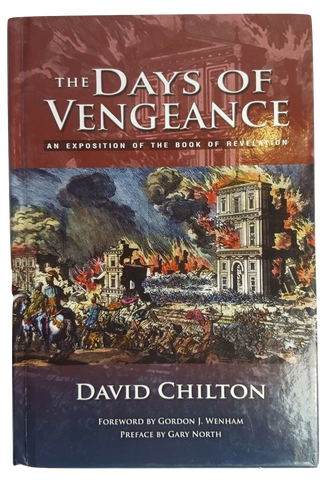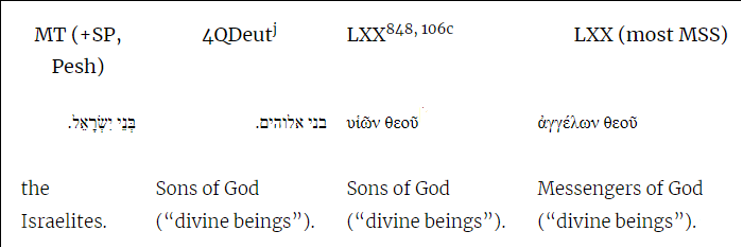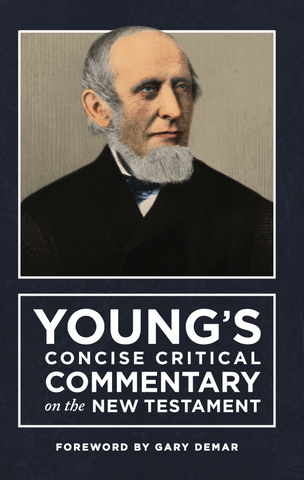For a few years I have been researching the debate over the “sons of God” or “angels of God" and the Nephilim. The amount of material on the topic is staggering. Much of it is downright crazy and sensationalistic, especially when eschatology is added to the mix. At the same time, many of the studies are scholarly by sticking to the biblical text. As a result, the topic has received a lot of attention. The number of YouTube videos, podcasts, and books prove it’s an ongoing point of interest. It seems that anything that taps into the supernatural piques people’s interest sometimes in an unhealthy way. The more I research the subject, the deeper and more eerie the hole gets. I’m nearing the stopping point because the same arguments keep recurring, not adding much that’s new to the debate.
Identifying the “sons of God” in Genesis 6:2 and 4 and Job 1:6 and 2:1 can get complicated because of translation issues. For example, some Greek translations of the Old Testament called the Septuagint (LXX)[1] translate Genesis 6:2 and 4 as “sons of God” and some Greek manuscripts translate the verses as “angels of God.”[2] The same is true for Job 1:6, 2:1, and 38:7. The Masoretic Hebrew text uses “sons of God” for all the verses. Some scholars question the accuracy of the Masoretic manuscript since it’s a late-date creation. The oldest known complete copy, the Leningrad Codex, dates to AD 1009. Most modern-day English translations are based on the Masoretic text, including the KJV. As expected, some scholars question the accuracy of the various Septuagint translations even though many of the OT references in the NT are based on the LXX. The Peshitta, an Aramaic translation of the entire Hebrew Bible that was written around the second century AD translates Genesis 6:2 and 4 and Job 1:6, 2:1 as “sons of God” while Job 38:7 is translated “the sons of the Angels.”

Days of Vengeance
David Chilton's extraordinary verse-by-verse exposition of Revelation is as welcome as a cool drenching rain upon a dry, thirsty ground. From the very beginning, cranks and crackpots have attempted to use Revelation to advocate some new twist on the Chicken Little Doctrine: "The Sky is Falling!" But, as David Chilton shows in this careful, detailed exposition, St. John's Apocalypse teaches instead that Christians will overcome all opposition through the work of Jesus Christ.
Buy NowThere’s an interesting debate over the proper translation of Deuteronomy 32:8, where the Hebrew reads “the sons of Israel,” a Deuteronomic fragment from the Dead Sea Scrolls reads “Sons of God,” while different LXX translations have “sons of God” or “angels of God.” It looks like this:

For the layperson, this type of scholarly debate can be frustrating and confusing. There is nearly unanimous agreement, however, that when it comes to Deuteronomy 32:8-9 that neither the “sons of God” nor the “angels of God” are fallen angels.
Before we get into the particulars of the interpretive consequences of identifying the “sons of God,” the “daughters of men,” and the Nephilim, it’s important to look at the flow of the context of what we find in Genesis 6:1-4 and ask questions about what is not mentioned. How would the first readers of these early verses in Genesis have understood them? Let’s begin by introducing the Sethite v. Cainite view, a popular alternative to the fallen angel view.
First, the Sethite (sons of God) v. Cainite (daughters of mankind) connection claims too much. Why use “sons of God” and “daughters of men” when “the sons of Seth” and “the daughters of Cain” would have made a better and clear parallel if this is what was intended? We can’t assume that all the descendants of Seth were righteous and all the descendants of Cain were unrighteous.
Second, why after nearly two chapters of genealogical lists (Gen. 4:16-5:32) and the flood narrative covering more than three chapters (6:8-9:17), do we find only four verses supposedly about evil angelic beings marrying or cohabitating with humans and creating a super race of giants? It seems that a demonic-inspired invasion that corrupted humanity resulting in a global flood would be developed in greater detail.
Third, beginning in Genesis, we are not given any information on who the “sons/angels of God” are. If “angels” is the correct translation, then the next time we encounter the word “angels” is in Genesis 19:1 where “son” (4:17, 25, 26) and “sons and daughters” (5:4, 7, 10, 13, 16, 19, 22, 26, 30) are found. In 18:2, 16, 22, and 19:16 angels disguised as “men” are mentioned. But these angelic “men” are not fallen angels. The only fallen being in these early chapters of Genesis is the serpent. Why isn’t he described as an “angel of God”?
Fourth, notice what follows in 6:5-7:
Then the LORD saw that the wickedness of mankind was great on the earth, and that every intent of the thoughts of their hearts was only evil continually. So the LORD was sorry that He had made mankind on the earth, and He was grieved in His heart. Then the LORD said, “I will wipe out mankind whom I have created from the face of the land; mankind, and animals as well, and crawling things, and the birds of the sky. For I am sorry that I have made them.”
Nothing is said about fallen angels. The fallen angels allegedly created this moral travesty, but it’s humans and animals who were judged.
• the wickedness of mankind was great (nothing is said about fallen angels)
• the LORD was sorry that He had made mankind (but God wasn’t sorry about making angels?)
• I will wipe out mankind (but not the fallen angels)
• mankind, and animals as well, and crawling things, and the birds of the sky (but not fallen angels)
Why aren’t these supposed fallen angels judged? There’s no mention of their judgment in their supposed part in the corruption of humanity. The serpent, the main antagonist in Genesis 3, is cursed, but nothing is said about fallen angels in Genesis 6 whether verses 2 and 4 are translated as “[fallen] angels of God” or “sons of God.”

Robert Young's Concise Critical Commentary on the NT
A concordance lists most every word in the Bible and gives its English translation. A concordance like Strong’s Exhaustive Concordance also serves as a basic Bible dictionary. Strong’s comes in printed and electronic forms. It is keyed to the KJV. This is why a literal translation of the Bible is helpful. In addition to his Analytical Concordance to the Bible—where the original Hebrew or Greek words are listed as well as the pronunciation—Robert Young (1822-1888) also published several editions of his Literal Translation of the Bible (YLT). He also published the Concise Critical Bible Commentary that was "Specially Designed for Those Teaching the Word of God."
Buy NowI’ve only scratched the surface in this short article. There’s a lot more to come. I could never be a lawyer. After preparing a legal brief or defense, I would always feel I left something out, overlooked a crucial piece of evidence, or didn’t anticipate an argument raised by my courtroom opponent. That’s the way feel in studying this topic. There are so many twisted roads, dead ends, and caves because of translation issues and operating assumptions, many of which are hard to prove, that it’s hard to keep it all straight. This expert sounds good until I read or listen to this expert. There are good people on both (three?) sides. I try to keep this verse in mind when I do research:
The first to plead his case seems right
Until another comes and examines him (Prov. 18:17).
[1] The Torah (the first five books of the Bible) are believed to have been translated from Hebrew into Greek in the 4th century BC. It’s called the Septuagint because of a legend that 70 or 72 Jewish scholars, thus LXX, who understood Greek and Hebrew, were called on to make a translation of the Pentateuch for the Greek-speaking world.
[2] Henry Barclay Swete’s LXX translation has “angels of God” (ἄγγελοι τοῦ θεοῦ). The Brenton LXX has “sons of God.” “One cannot simply say, ‘The LXX says…,’ because then inevitably an appropriate response is, ‘Which LXX? Which manuscript? Which or whose best attempt at reconstruction? So ‘approximation of the original’ and ‘hopefully the best which could be reconstructed’ are key phrases here.” (Source)

